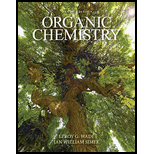
Concept explainers
(a)
To determine: The final product for the given reaction.
Interpretation: The final product for the given reaction is to be shown.
Concept introduction: Ozonlysis is a type of reaction in which ozone react with unsaturated compounds like
This type of reaction is used in synthesis and in analysis to known the double or triple bond positions of an organic compound.
(b)
To determine: The final product for the given reaction.
Interpretation: The final product for the given reaction is to be shown.
Concept introduction: Ozonlysis is a type of reaction in which ozone react with unsaturated compounds like alkenes or alkynes which results in the cleavage of the bond.
This type of reaction is used in synthesis and in analysis to known the double or triple bond positions of an organic compound.
(c)
To determine: The final product for the given reaction.
Interpretation: The final product for the given reaction is to be shown.
Concept introduction: Ozonlysis is a type of reaction in which ozone react with unsaturated compounds like alkenes or alkynes which results in the cleavage of the bond.
This type of reaction is used in synthesis and in analysis to known the double or triple bond positions of an organic compound.
(d)
To determine: The final product for the given reaction.
Interpretation: The final product for the given reaction is to be shown.
Concept introduction: Ozonlysis is a type of reaction in which ozone react with unsaturated compounds like alkenes or alkynes which results in the cleavage of the bond.
This type of reaction is used in synthesis and in analysis to known the double or triple bond positions of an organic compound.
Want to see the full answer?
Check out a sample textbook solution
Chapter 10 Solutions
Organic Chemistry Plus Mastering Chemistry with Pearson eText -- Access Card Package (9th Edition) (New in Organic Chemistry)
- H3C. H3C CH 3 CH 3 CH3 1. LDA 2. PhSeCl 3. H2O2arrow_forwardPlease predict the products for each of the following reactions: 1.03 2. H₂O NaNH, 1. n-BuLi 2. Mel A H₂ 10 9 0 H2SO4, H₂O HgSO4 Pd or Pt (catalyst) B 9 2 n-BuLi ♡ D2 (deuterium) Lindlar's Catalyst 1. NaNH2 2. EtBr Na, ND3 (deuterium) 2. H₂O2, NaOH 1. (Sia)2BH с Darrow_forwardin the scope of ontario SCH4U grade 12 course, please show ALL workarrow_forward
- Is the chemical reaction CuCl42-(green) + 4H2O <==> Cu(H2O)42+(blue) + 4Cl- exothermic or endothermic?arrow_forwardIf we react tetraethoxypropane with hydrazine, what is the product obtained (explain its formula). State the reason why the corresponding dialdehyde is not used.arrow_forwarddrawing, no aiarrow_forward
- If CH3COCH2CH(OCH3)2 (4,4-dimethoxy-2-butanone) and hydrazine react, two isomeric products are formed. State their structure and which will be the majority.arrow_forward+ Reset Provide the correct IUPAC name for the compound shown here. 4-methylhept-2-ene (Z)- (E)- 1-6-5-2-3-4- cyclo iso tert- sec- di tri hept hex oct meth eth pent ane yne ene ylarrow_forward+ Provide the correct IUPAC name for the compound shown here. Reset H3C H H C CH3 CH-CH3 1-3-methylpent ene trans- cis- 5-6-3-1-2-4- tert- tri sec- di cyclo iso but pent hex meth prop eth yl ane ene yne ☑arrow_forward

 Organic ChemistryChemistryISBN:9781305580350Author:William H. Brown, Brent L. Iverson, Eric Anslyn, Christopher S. FootePublisher:Cengage Learning
Organic ChemistryChemistryISBN:9781305580350Author:William H. Brown, Brent L. Iverson, Eric Anslyn, Christopher S. FootePublisher:Cengage Learning Organic Chemistry: A Guided InquiryChemistryISBN:9780618974122Author:Andrei StraumanisPublisher:Cengage Learning
Organic Chemistry: A Guided InquiryChemistryISBN:9780618974122Author:Andrei StraumanisPublisher:Cengage Learning EBK A SMALL SCALE APPROACH TO ORGANIC LChemistryISBN:9781305446021Author:LampmanPublisher:CENGAGE LEARNING - CONSIGNMENT
EBK A SMALL SCALE APPROACH TO ORGANIC LChemistryISBN:9781305446021Author:LampmanPublisher:CENGAGE LEARNING - CONSIGNMENT



